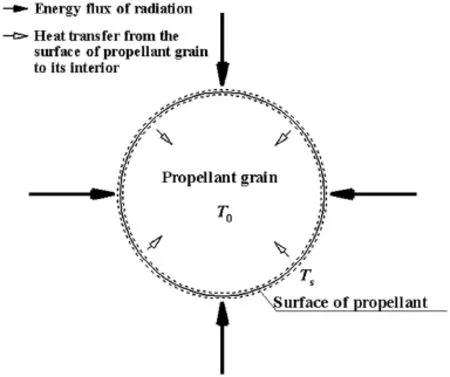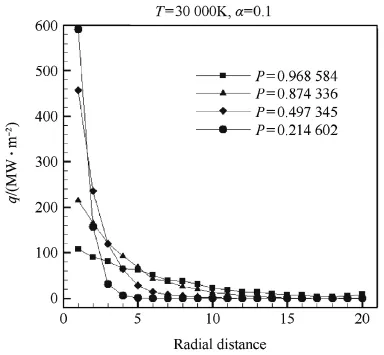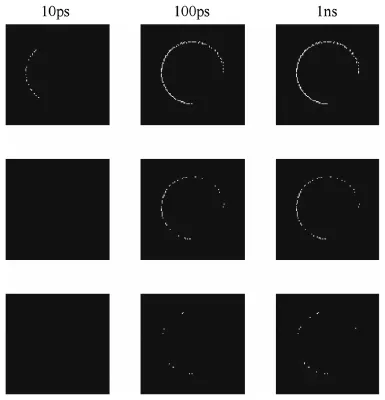Mechanism of plasma ignition in electrothermal-chemical launcher
Yong JIN,Yan-jie NI,Hai-yuan LI*,Bao-ming LI
National Key Laboratory of Transient Physics,Nanjing University of Science and Technology,Nanjing,Jiangsu 210094,China
Mechanism of plasma ignition in electrothermal-chemical launcher
Yong JIN,Yan-jie NI,Hai-yuan LI*,Bao-ming LI
National Key Laboratory of Transient Physics,Nanjing University of Science and Technology,Nanjing,Jiangsu 210094,China
Plasma generator is a core component in an electrothermal-chemical(ETC)launcher.Its work state directly inf l uences the launch eff i ciency of a system.The interaction between plasma and propellants is a very important mechanism in ETC technology.Based on the transient radiation model and open air plasma jet experiment,the mechanism of plasma ignition process is analyzed.Results show that the surface temperature of local solid propellant grain can quickly achieve the ignition temperature under the action of early transient plasma radiation.But it needs enough time to maintain the high energy f l ow to make self-sustained combustion of solid propellant grains.Because of the limited space characteristics of transient radiation,the near-f i eld propellant grains can gain enough energy by the strong transient radiation to be ignited and achieve self-sustained combustion.The far-f i eld propellant grains mainly gain the energy by the activated particles in plasma jet to be ignited and self-sustained combustion.Experiments show that plasma jet always has a high f l ow velocity in the area of the cartridge.Compared with conventional ignition,the solid propellant grains can obtain more quick and uniform ignition and self-sustained combustion by this kind of ablation controlled arc (ACA)plasma via energy skin effect of propellant grains,pre-heat temperature mechanism and high eff i cient jet diffusion.
Electrothermal-chemical launch;Plasma ignition;Transient radiation;Plasma jet
1.Introduction
Electrothermal-chemical(ETC)launch can be used to obtain more smooth interior ballistic process and improve the kinetic energy (KE)of the projectile relative to the conventional ballistics [1].Capillary structure is always designed and used as the ablation material to support the ablation controlled arc(ACA)plasma in ETC launchers [2].The features of an ACA hybrid plasma jet can be controlled and regulated accurately by the discharge parameters of a pulse power supply (PPS)[3]. This kind of high temperature transient plasma has a great advantage to improve the ignition and combustion of solid propellants compared with conventional ignition using energetic materials,such as black powder.Optimizing the structural design and work parameters of plasma generator is of considerable signif i cance in engineering applications.
The previous calculations and experiments show that the plasma temperatures ranged from 0.35 eV (4000 K)to 3 eV(35,000 K)[4,5].At the moment when plasma is injected into a propellant bed,energy is transferred rapidly to the propellantgrains nearby the plasma generator via instantaneous radiation,which might lead to ignition.There must be a strong radiation that may be used to optimize the ignition and combustion processes.After ignition,the plasma radiation is damped quickly through the high pressure gas produced by propellant burning. Energy is transferred quickly to the propellant grains far from the plasma generator via plasma jet diffusion.
Lots of works in theory and experiments have been done to investigate the plasma-propellant interaction,and the enhancement function of plasma has been proven by experiments.But the mechanisms of plasma ignition and enhancement in the ETC launch process have yet been understood clearly.In this paper,a transient radiation model and relevant plasma jet experiments are established to discuss and help to understand the mechanism of plasma ignition in the ETC launch process from the view of radiation and diffusion,respectively.
2.Near-f i eld:radiation
In our previous works [6,7],a Monte Carlo method was employed in an attempt to understand the characteristics of plasma and its interaction with propellant grains by the transient radiation at the moment of discharging.A threedimensional model was established to simulate the early transient radiation in cartridge based on the model in Ref.[6].Allpropellant grains are uniformly aligned around the serial arc plasma generator in the center of the cartridge,as shown in Fig.1,and are characterized by a porosityPand an average absorption coeff i cientα.HereP=Vp/V,whereVpis the volume of propellant andVis the volume of cartridge.

Fig.1.Schematic diagram of 3D radiation model.
The assumptions here are as the same as those in Ref. [6]. Plasma is a graybody radiator,and the radiant energyEbis

whereεis the emissivity;σis the Stefan-Boltzmann constant;andTis the plasma temperature.The temperature inside the plasma generator is assumed to be fi nite and constant.In our calculations,Tis assumed as 30,000 K.The radiant energy consists ofnenergy beams,and each energy beam has an energyEgiven by

We also assume that the radiation and absorption of propellant grains follow Kirchhoff’s law based on local thermodynamic equilibrium (LTE)conditions [8].The propellants are assumed to be spherical and have diffuse re fl ective surfaces. Their quantum absorption ΔEpis

whereαis the average absorption coeff i cient.We also assume that the scattering direction of the energy beam is random.And the wall of cartridge is assumed to have the same absorption characteristics as the propellant grains.
The gases in the cartridge are assumed to behave as optical f i lm and also are supposed to be in thermodynamic equilibrium(TE)with the attenuation to the energy beamE’described as

wheresis the length of the path andβis the attenuation coeff i cient of the gases in cartridge.βis assumed to be 0.01 in the calculations.
We also assume that all of the energy absorbed by the propellant grains is used to increase their surface temperatures.
The three-dimensional radiation model is coupled with a thermal model shown in Fig.2 to predict the surface temperature of propellant grains and the distribution of temperature in the cartridge.It is reasonable to assume that the radiative heat transfer from the plasma source to the surfaces of propellant grains is extremely eff i cient in a strong instantaneous radiation. Hence,the heat transfer from the surface of propellant grain to its interior is relatively slow.
The surface layer of propellant grains can be def i ned as the area in the dashed boundary in Fig.2,and the boundary of its surface layer is approximated as an adiabatic boundary.
The surface temperature of theith propellant grain can be written as

whereqiis the energy fl ux reaching the surface of the propellant grain,as calculated by the radiation model;T0is the initial temperature of propellant grains (288.15 K);Cpandλare the speci fi c heat at constant pressure and the thermal conductivity of propellant grain,respectively;mis the mass of propellant grain,m=5.149 g;Δtis the actual time of radiation;andkis the volume ratio of surface layer to propellant grain.Based on the parameters of JA2 [9],Cpandλof propellant grains are selected as 1520.45 J/(kg K)and 0.28 W/(m K),respectively. For a spherical particle,we have


Fig.2.Schematic diagram of propellant thermal model.

Fig.3.Distribution of radiation energy f l ux in cartridge forT=30,000 K,α=0.1,andP=0.717257.
whereRis the ratio of the surface layer thickness to the radius of propellant grain.The radius of propellant grain is on the order of 10-3m,and the molecular structure of large organic molecule is usually on the order of 10-7m.Hence,Ris assumed as 10,000 in our calculations withk≈ 0.0003.
It is anticipated that the heat transfer from the surface of propellant grain to its interior is minimal.The main function of radiation is the instantaneous heating to the surface layer of propellant grain,and the surface layer temperature can maintain a constant increasing trend as a result of the radiation.
2.1.Radiation distribution in cartridge
The distribution of radiant energy in the cartridge forT=30,000 K,α=0.1,andP=0.717257 is shown in Fig.3,whereαis the average absorption coeff i cient andPis the porosity in cartridge.The radiation distributions in axial and radial sections are shown in Fig.3(a)and (b),respectively.It clearly shows that the radiant energy peak f l ux is nearly 320 MW/m2in an area next to the plasma source.The effect of radiation energy is conf i ned to a small f i eld around the plasma generator in the propellant bed [10].
More calculations of different porosities are used to conf i rm the effective range of radiation in the cartridge.The radial distributions of radiant energy f l ux at different porosities are shown in Fig.4.Here the horizontal axis is propellant grains’position (normalized by the diameter of propellant grain).As shown in Fig.4,the farther the radial distance is,the less the radiation energy in the cartridge.The radiation energy becomes zero as the radial distance becomes more than 10 times of the propellant grain’s diameter.In the actual propellant bed,a high loading density (low porosity case)caused the penetration depth of radiation to be nearly 5 times the propellant grain’s diameter.Hence,we def i ne the near-f i eld propellant grains are those in 5 times the propellant grain’s diameter away with the plasma source,and the far-f i eld propellant grains are those far away with the plasma source more than 5 times of the propellant grain’s diameter.
2.2.Energy skin effect of propellant grains
Fig.5 shows the change of radiation intensity in the surface layer of propellant grains at 10 ps,100 ps,and 1 ns,where a,b,and c are spherical propellant grains shown in Fig.1,respectively.
Stronger radiation is shown as bright white color in Fig.5.It can be intuitively seen from Fig.5 that the radiation intensity decreases from a to c at different times as a result of the rapid attenuation of radiation intensity along the radial direction.The radiation intensity on the surface layer of propellant grains increases rapidly,suggesting that the surface layer of propellant particles has a high amount of absorbed radiation on it.Because the plasma generator is on the left side of propellant,the radiation energy intensity on the left side is stronger than that on the right side.It shows that the propellant grains can be ignited simply by radiation.The responses of the energy f l ux and surface temperature of propellant grains to radiation are both in picoseconds.The main cause for the fast response must be the high eff i cient local radiation near the plasma generator.

Fig.4.Radial distribution of radiation energy f l ux forT=30,000 K andα=0.1.

Fig.5.Radiation intensity on surface layerofpropellantgrain forT=30,000 K,α=0.1,andP=0.717257.
In the process of plasma ignition,the high eff i cient heat transfer causes the radiation energy to aggregate in the surface layer of propellant grain rapidly during early plasma radiation. There is not suff i cient time to transfer the energy from the surface of propellant grain to its interior.The energy absorbed is used to increase quickly the temperature in the surface layer of the propellant grains.Hence,the surface layer can reach the ignition temperature almost instantly.The energy skin effect on the propellant grain surface is the main cause of plasma ignition.
2.3.Pre-heat temperature mechanism
A statistical combustion model was used to simulate the changes of average temperature and pressure in the cartridge at the moment of initial burning.The time-dependent changes of average temperature and pressure in the cartridge were obtained by statistically analyzing the combustion situation of propellant grain inside the cartridge allowed.
As the same as above assumption,the ignition sequence is determined when plasma temperature is 30,000 K.The ignition criterion is introduced as follows:if the temperature on the surface layer of a propellant grain reaches the ignition temperatureTc(600 K),the propellant grain absorbs enough energy generated by the plasma radiation to begin burning instantaneously.
The statistical average temperature and pressure in the cartridge within the initial several microseconds are shown in Fig.6.The experimental pressure at forcing cone,which can be approximated to the average pressure in the cartridge,is shown as the experimental pressure curve in Fig.6 when the loading density is 0.5 kg/L with porosityPof nearly 0.7 in a 105 mm ETC launcher.The pressure was measured using a KISTLER 6215 quartz high-pressure sensor.It is shown that the calculated pressure curve is in good agreement with the experimental one. The average pressure in the cartridge began to increase sharply from 1 μs.But the average temperature increased rapidly from zerotime,andthegradientofaveragetemperaturef i rstincreased and then decreased.Thus,the establishment of the temperature f i eld in the cartridge is prior to that of the pressure f i eld.

Fig.6.Statistical average temperature and pressure in the cartridge forT=30,000 K,α=0.1,andP=0.717 257.
Itissupposedthattheplasmaradiationcantransfertheenergy eff i ciently and causes an initial transient temperature f i eld near the plasma source.The pre-heat temperature f i eld caused by plasma radiation is benef i cial to ignition and combustion in the propellant bed.In conventional ignition,the main mode of energy transfer is convective conduction rather than radiation. Obviously,theuseofplasmainignitionensuresahighereff i cient and more precise ignition time.The pre-heat temperature mechanism cannot be obtained in conventional launch.
3.Far-f i eld:diffusion
The research above indicates that the propellant bed has a screening effect on the arc plasma radiation.Some local solid propellant grains around the plasma generator can quickly achieve the ignition point under the action of early strong instantaneous plasma radiation.But it needs enough time to maintain the high energy f l ow to achieve the self-sustained combustion of solid propellant grains.After these local propellant grains begin to burn,the combustion products,such as high temperature gas,change the optical properties of radiation in the cartridge,and the radiation is attenuated rapidly.Thus,the far-f i eld propellant grains mainly gain the energy from the activated particles in plasma jet.Plasma diffusion becomes the main way to transfer the energy.
Open air tests offered visualization of undisturbed plasma jet f l ows.The test results may help to understand the complex f l ow f i elds presenting in the propellant bed.An open air f i ring experimental system was designed and constructed to identify the diffusion characteristics of ACA plasma jet [11].The experimental system is shown in Fig.7.A Phantom V710 high-speed camera was used to collect the real-time images which were compared with background scale to determine the location of plasma jet boundary and the diffusion velocity of plasma.

Fig.7.Open air f i ring experimental system for ACA plasma generator.
A matched PPS device was used to supply a pulse current for the plasma generator,for which the peak current and full width at half maximum (FWHM)are nearly 160 kA and 3 ms,respectively.The electrical explosion time was about 147 μs.Fig.8 shows the high-speed images of ACA plasma diffusion in the early 330 μs of pulse discharging process.
It is shown that the arc plasma has a controllable boundary with the pulse current waveform.Both axial and radial diffusions occur under normal pressure at the same time.The calculated result shows that the radial diffusion velocity is nearly 333 m/s,similar to the local speed of sound.The axial diffusion velocity is higher than the radial one,which can reach approximately Mach 5.Hence,the plasma can f i ll the whole chamber quickly after transient radiation.Plasma diffusion brings the activated particles and energy to the propellant grains which are far away from the plasma generator.
4.Conclusion
In order to discuss and analyze the mechanism of plasma ignition in electrothermal-chemical (ETC)launch process,a 3-D transient radiation model and plasma jet air f i ring experiment were established to investigate the main energy transfer ways of the ablation controlled arc (ACA)plasma from the consideration of theory and experiment.

Fig.8.High-speedimagesofACAplasmageneratoropenairf i ringexperiment.
Theresultsshowthatthiskindoftransientplasmahasagreat advantage to improve the ignition and combustion of solid propellants.Becausethepropellantbedhasascreeningeffecton theACA plasma radiation,near-f i eld propellant grains can gain enough energy from the early strong transient radiation to be ignited and achieveself-sustained combustion.Far-f i eld propellant grains mainly gain the energy from the activated particlesintheplasmajettobeignitedandachieveself-sustained combustion.Experiments show that this plasma jet always has a higher axial diffusion velocity.Far-f i eld solid propellant grains can obtain more quick and uniform ignition and self-sustained combustion by the high velocity plasma jet.The ignition time in the cartridge is greatly shortened by using the high-eff i ciency energy transfer way:radiation and diffusion ofACA plasma.
Both radiation and diffusion characteristics of plasma should be considered in engineering design and experiments to optimize the ignition and combustion of propellant grain in order to improve the interior ballistic performance of ETC launcher.
Our future work will be to optimize the plasma generator structures to obtain better quality plasma.The ACA plasma diffusion details will be discussed both in theory and experiment.A series of experiments will be executed to explore the relationship among plasma temperature distribution,diffusion velocity and input pulse current parameters and help in building theACA plasma diffusion calculation model.The radiation and diffusion characteristics ofACA plasma in a real propellant bed will also be considered and conf i rmed in our future simulations and experiments.
[1]Woodley CR.A parametric study for an electrothermal-chemical artillery weapon.IEEE Trans Magn 1993;29(1):625-30.
[2]Dyvik J,Herbig J,Appleton R,O’Reilly J,Shin J.Recent activities in electrothermal chemical launcher technologies at BAE systems.IEEE Trans Magn 2007;43(1):303-7.
[3]Porwitzky AJ,Keidar M,Boyd ID.Progress towards an end-to-end model of an electrothermal chemical gun.IEEETrans Magn 2009;45(1):412-16.
[4]Zoler D,Shaf i r N,Forte D,Kot E,Ravid A,Wald S,et al.Study of plasma jet capabilities to produce uniform ignition of propellants,ballistic gain,and signif i cant decrease of the “temperature gradient”.IEEE Trans Magn 2007;43(1):322-8.
[5]Winfrey AL,Abd Al-Halim MA,Mittal S,Bourham MA.Study of high-enthalpy electrothermal energetic plasma source concept.IEEE Trans Plasma Sci 2015;43(7):2195-2200.
[6]Jin Y,Li B.Energy skin effect of propellant particles in electrothermalchemical launcher.IEEE Trans Plasma Sci 2013;41(5):1112-16.
[7]Jin Y,Li B.Calculation of plasma radiation in electrothermal-chemical launcher.Plasma Sci Technol 2014;16(1):50-3.
[8]Kappen K,Bauder U.Calculation of plasma radiation transport for description of propellant ignition and simulation of interior ballistics in ETC guns.IEEE Trans Magn 2001;37(1):169-72.
[9]Porwitzky AJ,Keidar M,Boyd ID.Modeling of the plasma-propellant interaction.IEEE Trans Magn 2007;43(1):313-17.
[10]Porwitzky AJ,Keidar M,Boyd ID.Numerical parametric study of the capillary plasma source for electrothermal-chemical guns.IEEE Trans Magn 2009;45(1):574-7.
[11]Kim S-H,Yang K-S,Lee S-W,Jung J-W.Capillary discharge in the open air.IEEE Trans Magn 2003;39(1):244-7.
Received 29 September 2015;revised 28 December 2015;accepted 28 December 2015 Available online 28 January 2016
Peer review under responsibility of China Ordnance Society.
*Corresponding author.Tel.:+8602584315938806.
E-mail address:li_haiyuan@163.com (H.Y.LI).
http://dx.doi.org/10.1016/j.dt.2015.12.009
2214-9147/© 2016 China Ordnance Society.Production and hosting by Elsevier B.V.All rights reserved.
© 2016 China Ordnance Society.Production and hosting by Elsevier B.V.All rights reserved.
- Defence Technology的其它文章
- 3D numerical simulation and analysis of railgun gouging mechanism
- Calculation of propellant gas pressure by simple extended corresponding state principle
- Application of transient burning rate model of solid propellant in electrothermal-chemical launch simulation
- Innovative boron nitride-doped propellants
- The ballistic performance of the bombard Mons Meg

